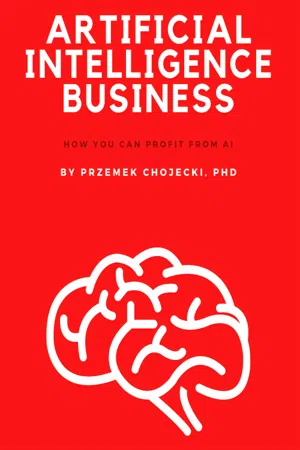
- 150 pages
- English
- ePUB (mobile friendly)
- Available on iOS & Android
Artificial Intelligence Business: How you can profit from AI
About this book
The concise guide to artificial intelligence for business people and commercially oriented data scientistsKey Features• Find out how artificial intelligence is shaping the future of businesses• Discover how AI influences the society and its politics and economy• Explore the future of AI and its applicationsBook DescriptionWe're living in revolutionary times. Artificial intelligence is changing how the world operates and it determines how smooth certain processes are.For instance, when you go on a holiday, multiple services allow you to find the most convenient flights and the best hotels, you get personalized suggestions on what you might want to see, and you go to the airport via one of the ride-sharing apps. At each of these steps, AI algorithms are at work for your convenience. This book will guide you through everything, from what AI is to how it influences our economy and society.The book starts with an introduction to artificial intelligence and machine learning, and explains the importance of AI in the modern world. You'll explore how start-ups make key decisions with AI and how AI plays a major role in boosting businesses. Next, you'll find out how media companies use image generation techniques to create engaging content. As you progress, you'll explore how text generation and AI chatbot models simplify our daily lives. Toward the end, you'll understand the importance of AI in the education and healthcare sectors, and realize the risks associated with AI and how we can leverage AI effectively to help us in the future.By the end of this book, you'll have learned how machine learning works and have a solid understanding of the recent business applications of AI.What you will learn• Find out how AI helps in building innovative cultures in enterprises• Understand how AI boosts start-ups• Discover modern AI trends in the field of manufacturing and logistics• Explore the benefits of text and image generation applications• Study popular machine learning trends and their usage• Uncover the uses of AI in politics and societyWho this book is forThis book is for artificial intelligence enthusiasts or anyone with a business background who wants to learn how AI can scale up businesses.
Frequently asked questions
- Essential is ideal for learners and professionals who enjoy exploring a wide range of subjects. Access the Essential Library with 800,000+ trusted titles and best-sellers across business, personal growth, and the humanities. Includes unlimited reading time and Standard Read Aloud voice.
- Complete: Perfect for advanced learners and researchers needing full, unrestricted access. Unlock 1.4M+ books across hundreds of subjects, including academic and specialized titles. The Complete Plan also includes advanced features like Premium Read Aloud and Research Assistant.
Please note we cannot support devices running on iOS 13 and Android 7 or earlier. Learn more about using the app.
Information
Trends in Artificial Intelligence
- Autonomous machines
- Automated processes
- Optimized processes with human supervision
- tasks and occupations, for example, using computer vision to free up radiologists’ time in detecting potential cancer cells.
- business processes, for example, Amazon warehouses introducing robots and optimization algorithms to their workflow.
- business models, for instance, going from pricing for an individual product (song, movie) to a subscription model based on personalised recommendations a’la Netflix or Spotify.
Table of contents
- Introduction
- A short history of Artificial Intelligence
- Practical AI and how it is done
- Powering Enterprises with AI
- Boosting Startups with Artificial Intelligence
- One person enhanced with AI
- Trends in Artificial Intelligence
- Machine Learning Trends
- AI, Politics and Society
- Future of Artificial Intelligence